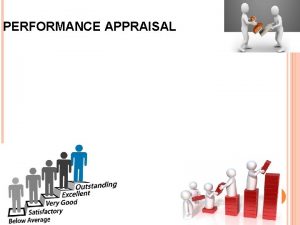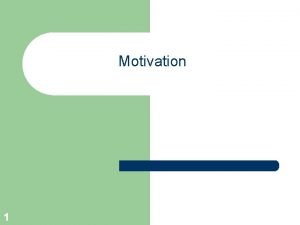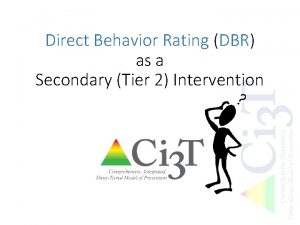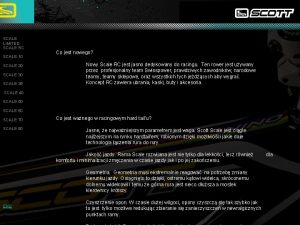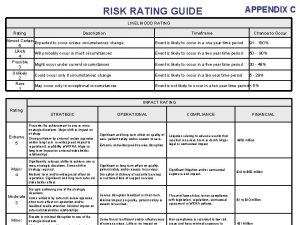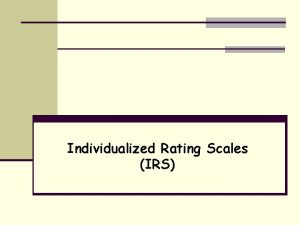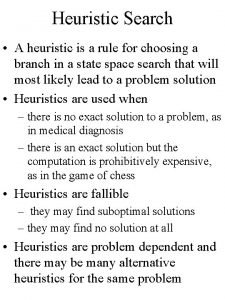Outline Modified rating scale Heuristic evaluation Modified rating






































- Slides: 38


Outline • Modified rating scale • Heuristic evaluation

Modified rating scale • • • -4: -3: -2: -1: 0: +1: +2: +3: +4: usability catastrophe—imperative to fix before major usability problem–important to fix minor usability problem–low priority cosmetic problem only–need not be fixed not a real usability problem or merit cosmetic merit minor usability merit major usability merit usability excellence

Heuristic Evaluation of Swing

Explicit interactor tree add – Must ensure interactor tree gets added in order to see anything. – Beginners get baffled.


Explicit interactor tree add – Must ensure interactor tree gets added in order to see anything. – Beginners get baffled. – Rating?

Explicit interactor tree add – Must ensure interactor tree gets added in order to see anything. – Beginners get baffled. – Rating: -2 for Visibility

Informative runtime errors • Incompatibilites with AWT addressed with quick exits and error printlns • Exception in thread "main" java. lang. Error: Do not use javax. swing. JFrame. set. Layout() use javax. swing. JFrame. get. Content. Pane(). set. Layout() instead

Informative runtime errors • Incompatibilites with AWT addressed with quick exits and error printlns • Exception in thread "main" java. lang. Error: Do not use javax. swing. JFrame. set. Layout() use javax. swing. JFrame. get. Content. Pane(). set. Layout() instead • Rating?

Informative runtime errors • Incompatibilites with AWT addressed with quick exits and error printlns • Exception in thread "main" java. lang. Error: Do not use javax. swing. JFrame. set. Layout() use javax. swing. JFrame. get. Content. Pane(). set. Layout() instead • Rating: +3 for Error recovery

Bad constructor abstractions + The Swing API keeps improving with abstractions such as the set. Default. Close. Operation method for the JFrame - However, several annoyances persist …


Bad constructor abstractions + The Swing API keeps improving with abstractions such as the set. Default. Close. Operation method for the JFrame - However, several annoyances persist … - Rating?

Bad constructor abstractions + The Swing API keeps improving with abstractions such as the set. Default. Close. Operation method for the JFrame - However, several annoyances persist … - Rating: -2 for Flexibility

Dependence on call order - Methods that depend on other certain actions to have been made need to be well documented

Dependence on call order - Methods that depend on other certain actions to have been made need to be well documented - What’s wrong with the following snippet? button. set. Bounds(10, 10, 10); frame. set. Visible(true); frame. get. Content. Pane(). add(button);

Dependence on call order - Methods that depend on other certain actions to have been made need to be well documented - What’s wrong with the following snippet? button. set. Bounds(10, 10, 10); frame. set. Visible(true); frame. get. Content. Pane(). add(button); Rating?

Dependence on call order - Methods that depend on other certain actions to have been made need to be well documented - What’s wrong with the following snippet? button. set. Bounds(10, 10, 10); frame. set. Visible(true); frame. get. Content. Pane(). add(button); Rating: -4 for Error prevention

Method call collisions - Some methods override each other - set. Size and pack - Javadoc says pack affects the size, but that’s more obscure; rename to pack. To. Preferred. Size perhaps

Method call collisions - Some methods override each other - set. Size and pack - Javadoc says pack affects the size, but that’s more obscure; rename to pack. To. Preferred. Size perhaps - Rating?

Method call collisions - Some methods override each other - set. Size and pack - Javadoc says pack affects the size, but that’s more obscure; rename to pack. To. Preferred. Size perhaps - Rating: -2 for Error prevention

A line for every attribute - Programming at the toolkit level implies an extra line of code for every attribute and pack - Tradeoff: attributes explicitly set, but hard to see the context … - set. Size


A line for every attribute - Programming at the toolkit level implies an extra line of code for every attribute and pack - Tradeoff: attributes explicitly set, but hard to see the context … - Rating? - set. Size

A line for every attribute - Programming at the toolkit level implies an extra line of code for every attribute and pack - Tradeoff: attributes explicitly set, but hard to see the context … - Rating: +3 for Aesthetics - set. Size

Other heuristics - Javadoc



Other heuristics - Javadoc

Other heuristics - Javadoc: +3 for Documentation

Other heuristics - Javadoc: +3 for Documentation - Language counterparts

Other heuristics - Javadoc: +3 for Documentation - Language counterparts: +4 for Match - Swing. Utilities. invoke. Later:

Other heuristics - Javadoc: +3 for Documentation Language counterparts: +4 for Match Swing. Utilities. invoke. Later: -2 for Error prevent Panes

Other heuristics - Javadoc: +3 for Documentation Language counterparts: +4 for Match Swing. Utilities. invoke. Later: -2 for Error prevent Panes: -1 for Consistency Layouts hard to author

Other heuristics - Javadoc: +3 for Documentation Language counterparts: +4 for Match Swing. Utilities. invoke. Later: -2 for Error prevent Panes: -1 for Consistency Layouts hard to author: -3 for User control

Summary • • • Visibility of system status (1 bad) Match of system & real world (1 good) User control and freedom (1 bad) Consistency and standards (1 bad) Error prevention (3 bad) Recognition rather than recall (not used) Flexibility and efficiency of use (1 bad) Aesthetic and minimalist design (1 good) Error recovery (1 good) Documentation and help (1 good)

Conclusion • Still not too bad • Object-oriented is the way to go • Can create a wide variety of GUIs
 Cognitive walkthrough vs heuristic evaluation
Cognitive walkthrough vs heuristic evaluation Heuristic evaluation meaning
Heuristic evaluation meaning Heuristic evaluation checklist
Heuristic evaluation checklist Cognitive walkthrough vs heuristic evaluation
Cognitive walkthrough vs heuristic evaluation User interface design and implementation
User interface design and implementation Cognitive walkthrough example
Cognitive walkthrough example Cognitive walkthrough and heuristic evaluation
Cognitive walkthrough and heuristic evaluation Heuristic evaluation function
Heuristic evaluation function Heuristic evaluation
Heuristic evaluation Heuristic evaluation of user interfaces
Heuristic evaluation of user interfaces Heuristic evaluation presentation
Heuristic evaluation presentation Riset rating dan non rating
Riset rating dan non rating D&b supplier evaluation risk rating
D&b supplier evaluation risk rating Workday rating scale
Workday rating scale Value questions examples
Value questions examples Performance rating scale examples
Performance rating scale examples Supports intensity scale rating key
Supports intensity scale rating key Texasassessment telpas training center
Texasassessment telpas training center Individual performance contract rating (ipcr) form
Individual performance contract rating (ipcr) form Ssis age range
Ssis age range Summated rating scale adalah
Summated rating scale adalah Va ptsd rating scale pdf
Va ptsd rating scale pdf Checklist method
Checklist method Graphic rating scales
Graphic rating scales Graphic rating scale example
Graphic rating scale example Checklist method of performance appraisal
Checklist method of performance appraisal Behaviorally anchored rating scale
Behaviorally anchored rating scale Pcit therapy
Pcit therapy Lintrinsic
Lintrinsic Credit rating scale
Credit rating scale Skoring skala likert
Skoring skala likert Semantic differential scale example
Semantic differential scale example Graphic rating scale method
Graphic rating scale method Graphic rating scale method
Graphic rating scale method Presentation rating scale
Presentation rating scale Ip rating scale
Ip rating scale Tanner staging male
Tanner staging male Direct behavior rating scale
Direct behavior rating scale Frankel behaviour rating scale
Frankel behaviour rating scale


























